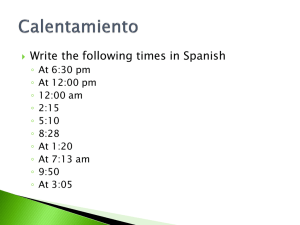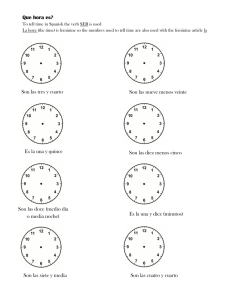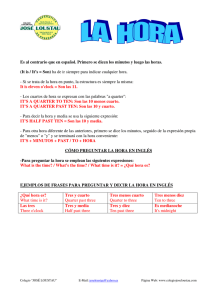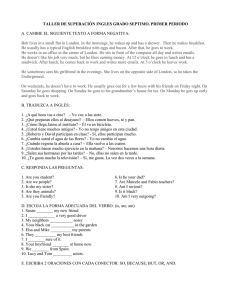2.7 Telling the Time Language Lesson
Anuncio
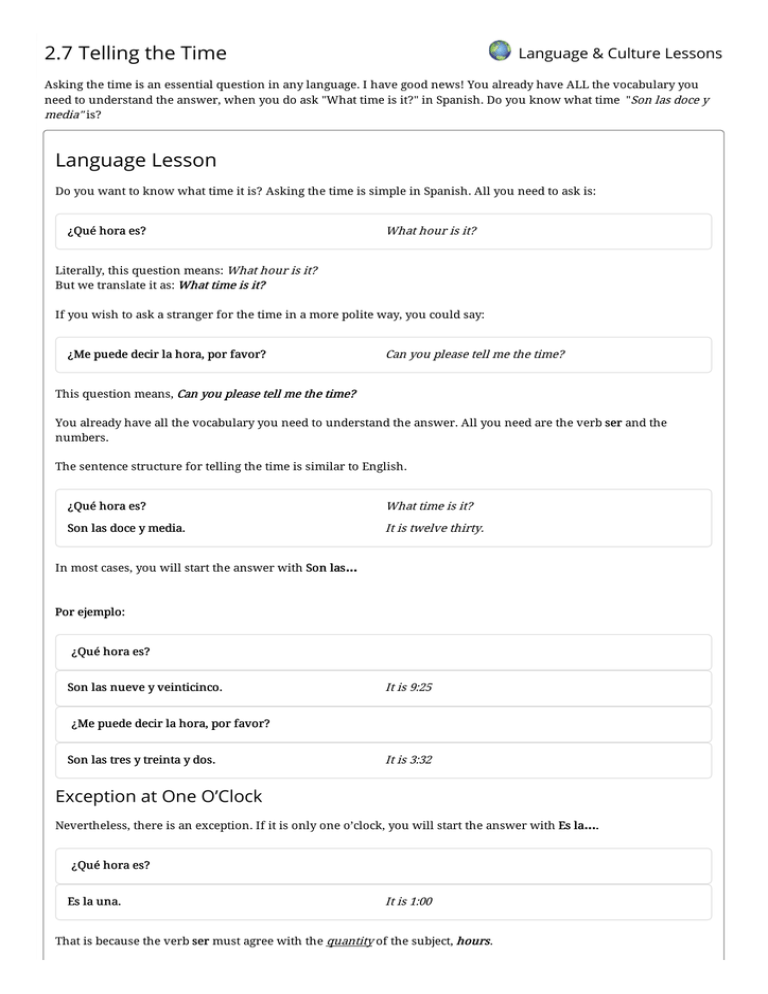
2.7 Telling the Time Language & Culture Lessons Asking the time is an essential question in any language. I have good news! You already have ALL the vocabulary you need to understand the answer, when you do ask "What time is it?" in Spanish. Do you know what time "Son las doce y media" is? Language Lesson Do you want to know what time it is? Asking the time is simple in Spanish. All you need to ask is: ¿Qué hora es? What hour is it? Literally, this question means: What hour is it? But we translate it as: What time is it? If you wish to ask a stranger for the time in a more polite way, you could say: ¿Me puede decir la hora, por favor? Can you please tell me the time? This question means, Can you please tell me the time? You already have all the vocabulary you need to understand the answer. All you need are the verb ser and the numbers. The sentence structure for telling the time is similar to English. ¿Qué hora es? What time is it? Son las doce y media. It is twelve thirty. In most cases, you will start the answer with Son las… Por ejemplo: ¿Qué hora es? Son las nueve y veinticinco. It is 9:25 ¿Me puede decir la hora, por favor? Son las tres y treinta y dos. It is 3:32 Exception at One O’Clock Nevertheless, there is an exception. If it is only one o’clock, you will start the answer with Es la…. ¿Qué hora es? Es la una. It is 1:00 That is because the verb ser must agree with the quantity of the subject, hours. Do you know why the feminine "la" and "las" are used? Hint: what gender is "hora"? International Variations In some parts of the Spanish-speaking world, you hear the question, “¿Qué hora es? ” asked as “¿Qué hora son? ” Your answer will always begin “Son las…”, regardless of whether the hour that follows is singular or multiple. Por ejemplo … A: ¿Qué hora son? B: Son las una. Talking about Quarter Hours and Thirty Minutes As in English, you can also tell the time in 15- or 30-minute chunks. 15 min/quarter = cuarto 30 min/half = media Por ejemplo: ¿Qué hora es? (2:15) Son las dos y cuarto. It’s a quarter past two. ¿Qué hora es? (1:30) Es la una y media. It’s half past one. You can also tell how much time remains until striking the hour. For example: a quarter to… = cuarto para las... ¿Qué hora es? (3:45) Es cuarto para las cuatro. It's a quarter to four. ¿Qué hora es? (2:55) Son cinco para las tres. It's five to three. Is it Morning or Night? You can indicate morning or afternoon by using am and pm just as you would in English. Alternatively, you may say... de la mañana in the morning de la tarde in the afternoon de la noche in the evening Por ejemplo: Son las diez y veintitrés de la mañana It is 10:23am Son las seis y cinco de la tarde It is 6:05pm Es cuarto para las doce de la noche It is 11:45pm Asking at What Time Something will Occur When you need to ask the time that a meeting or certain activity is going to take place, you can use the phrase: ¿A qué hora…? At what time...? Por ejemplo: ¿A qué hora te levantaste hoy? At what time did you get up today? Culture Transport In the most isolated regions of Latin America, the most common mode of transport is the bus. Cheap, and relatively efficient, buses are a popular choice among tourists. Trains are mostly used for the transport of goods throughout the country, or to take tourists to specific destinations. The famous journey from Lake Titicaca to the Machu Pichu ruins in Peru is frequented by tourists, as is the route from Buenos Aires to Bariloche, in Argentina. Luckily, low cost airlines are increasingly servicing more and more regions. Domestic and international flights to and from Brazil, as well as domestic flights in Colombia are now commonplace. LAN Airlines, which owns passenger subsidiaries in Peru, Chile, Argentina and Ecuador, offers domestic flights throughout South America with discount fares for frequent flyers. If you manage to snap up an airfare on special, you might expect to pay $250 for a return ticket from Sao Paulo (Brazil) to Santiago (Chile). It's certainly not as cheap as travel in other areas of the world, but prices are becoming more competitive as new airlines chase a piece of the market pie. Libros Media Ltd. - Copyright 2004-2014 USA: 10660 Page Avenue, PO Box 1261, Fairfax, VA 22038, USA | Phone: 703-349-0452 Asia/Pacific: 2-1008 Ferry Road, Woolston, Christchurch 8023, New Zealand | Phone: +64-3-384-6350
